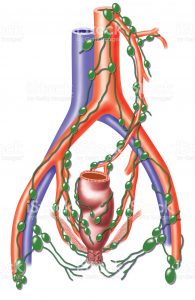 The lymphatic system is a completely separate system to any other in the body. We carry between 5L to 8L of lymph fluid at any one time. The lymphatic system filters excess protein, bacteria and fluid from the muscles and veins. It relies on muscle contraction to move fluid around the body. Lymphatic drainage can be done before and after an operation. Fluid pools causing swelling because the nodes have been compromised and the muscles are not contracting efficiently enough to empty the nodes. We have hundreds of nodes through out our bodies. The nodes take up waste to filter and cleanse then return back to the blood stream as plasma via ducts that are just above the collarbone. When doing lymphatic drainage there is a certain pattern you need to follow to empty the nodes. The massage is gentle and slow. The reason for this is if you press the nodes too hard the fluid will empty back into the body. Also the slow speed is to create a pumping action so all the nodes are contracting at once. There are also organs that are part of the system including the thymus, spleen, tonsils and appendix. These organs are called lymphoid and they contain immune cells. The right side of the lymphatic system only takes up 1/3 the right arm and torso while the left takes up 2/3 of the lower limbs legs, arm and torso. After the massage you should feel light and less restricted throughout the body.
The lymphatic system is a completely separate system to any other in the body. We carry between 5L to 8L of lymph fluid at any one time. The lymphatic system filters excess protein, bacteria and fluid from the muscles and veins. It relies on muscle contraction to move fluid around the body. Lymphatic drainage can be done before and after an operation. Fluid pools causing swelling because the nodes have been compromised and the muscles are not contracting efficiently enough to empty the nodes. We have hundreds of nodes through out our bodies. The nodes take up waste to filter and cleanse then return back to the blood stream as plasma via ducts that are just above the collarbone. When doing lymphatic drainage there is a certain pattern you need to follow to empty the nodes. The massage is gentle and slow. The reason for this is if you press the nodes too hard the fluid will empty back into the body. Also the slow speed is to create a pumping action so all the nodes are contracting at once. There are also organs that are part of the system including the thymus, spleen, tonsils and appendix. These organs are called lymphoid and they contain immune cells. The right side of the lymphatic system only takes up 1/3 the right arm and torso while the left takes up 2/3 of the lower limbs legs, arm and torso. After the massage you should feel light and less restricted throughout the body.
Lymphatic Drainage for Mastitis
Lymphatic drainage is also beneficial for mastitis – a painful condition for some new mothers.
Lymphatic Drainage for Blocked Sinuses
Blocked and infected sinuses can also benefit from a lymphatic drainage of the face. The structure of the sinus bone is very similar to a sponge. When doing a lymphatic drainage of the face you cause a suction that allows the tiny crevices to unblock, allowing the congestion to empty.

